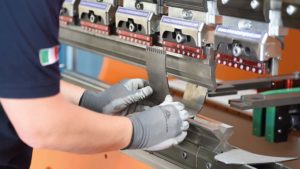The bending operator is a specialized worker who, besides producing good-quality parts, is also required to optimize the process. here are some practical suggestions.
Emiliano Corrieri
Whoever knows, or has read something about the “lean manufacturing”, perfectly knows what pillars rule such approach to the world of work. Several logics must be revised, many axioms are overturned in the wake of a common fundamental that compels to open our mind and to learn “to be broadminded”. Without investigating the methods and the stories of the illustrious forerunners of the manifold disciplines inherent to the quality and efficiency rise, it is however interesting to mention the famous “Ohno circle” because it is an as simple and effective technique that educates to rethinking of processes through the identification of wastes. It shows how it is important to be able “to set aside” our own habits, taking up ideally a point where enjoying an extraneous and new overview enabling to change perspective and to assess new aspects, ignored until few moments before. Ohno, just to know, was a famous and venerable manager of Toyota who was used to educating the new team leaders making them stand for hours and hours inside a circle he traced on the ground with a stick. The order was: «look and observe all that you see and that can be improved. Without getting out». I want to extend the concept to my world, press bending.
The “problem solver” bending operator
I often meet very skilled and passionate operators who, however, owing to a shortage of awareness, neglect the method. I explain better: nowadays the clever bending worker can no longer be only the operator who accomplishes an exact good-quality piece. Today the market calls also for a certain “problem solving” capability and a strong bent for the optimization of processes, at least in the realities (the majority of Italian ones) where machining outputs consist of small heterogeneous batches with breathtaking deliveries. That is the reason why the clever bending operator must necessarily accomplish the well-done work in the right time, making the fewest possible mistakes and with the intimate commitment to improve from time to time. Let us say the era of the “pedal thrusting” has almost ended. Yes, but from what should we start? Here is another very “lean” concept that, I daresay, shows the entire Japanese frugality: from what is already existing! Due to the lucky chance of having worked for years on bending machines, I know for certain that there are enormous improvement margins from the strictly operational point of view. Improvement that must go hand in hand with the business management organization one. For this reason, in the Bending Academy Courses I also focus on the strictly operational aspects that share in a higher quality and efficiency, without changing a single word!
Suggestions to reduce process times
1) Excellence in front of the press. The operator must keep the working area clean and in perfect order. Therefore, let us get off our feet those flying cables and those extensions that power stereos, fans, battery chargers for smartphone, refrigerators and any other gadget. The matter is not depriving workers of all comforts but dropping in production and putting everything in order, maybe with the aid of an electrician and inserting an additional plate, with the advantage of eliminating the risk of tripping. No scraps, and even less scattered drawings: each type of piece corresponds to a single drawing that faithfully accompanies it in the successive machining.
2) Only what is useful. Do you know Pareto theory? I suggest it to you, apply it!
Adapted to our world, it means that «20% of tools is useful for 80% of works».
Then, why having the entire Beta cart overturned between your feet if you use, most likely, an 8 Allen wrench, a protractor, a square (perhaps purposely made, like the one I supply in «Professional» courses), a hammer (the bending worker’s best friend) and a gauge? Dispassionate advice is to make a small frame where to hang only what you need for each machine and another (which can also be shared with the other operators) with the less used tools. Obviously, everything must be tidied up in the only place where it should stay.
3) Smart layout. What does it mean? Simple: creating ergonomics in front of the machine.
Benefitting from the widened space thanks to the order and the cleanliness examined in item number 1, we can park pieces smartly. To do that we must first identify the machining phases, then choose a loading and unloading zone requiring the least possible displacements and the least possible unnatural movements. What kind of bending operator is at stake, if I make 100 pieces very well but, besides bending, I run the New York marathon? Let us remember that a bending operator is a highly specialized worker who creates value only when he bends, not when he has a walk…The sizes, the shape, and the quantity (for intermediate phases, for instance) of loading and unloading areas can change. It is up to the operator’s phantasy, combined with experience, to organize spaces according to machining. It is a small preliminary study that, taking just few minutes of planning, can avoid notable wastes.
4) Optimization of CNC programmes. You can have endless improvement possibilities “playing” with the numerical control of the machine. For instance, choosing a work sequence that avoids re-bending, rotations or others. Then, the lowering of the Top Dead Centre that allows avoiding hundreds of idle strokes with consequent wastes of time. In addition, the correct use of photocells can save a lot of time. For instance, setting the box modality that allows a fast descent of the crossbeam up to the speed change point.
5) Quality. This aspect is achieved through a methodology to be acquired, unless already mastered, which is aimed at the pursuit of the “zero defect”, as well as the error reduction. For this reason, I decided to write a “Check list” for operators consisting of simple procedures that allow avoiding errors and increasing productivity, without having to pay one Euro, maintaining the positive things already existing in the company.
Didascalia
Foto autore: MR. Emilano Corrieri, teacher and founder of “Accademia della Piegatura”.







